Abstract
1 N,N-Dimethyltryptamine (DMT) in pargyline pretreated rodents induced a dose-dependent behavioural syndrome consisting of hyperactivity, prostration and hindlimb abduction, mild tremor, Straub tail, retropulsion and jerking. 2 In rats pretreated with pargyline, the behavioural syndrome induced by DMT differed from that induced by L-tryptophan or quipazine, in the lack of forepaw treading and head-weaving and in the presence of only mild tremor. 3 The hyperactivity component of the DMT-induced behavioural syndrome in pargyline-pretreated mice was potentiated by cyproheptadine, methergoline, and mianserin, inhibited by cinanserin, haloperidol, pimozide, methiothepin and propranolol, and not affected by 501C67-sulphate and methysergide. 4 The maximal behavioural changes induced by DMT in rats, other than hyperactivity, were unaffected by pretreatment with cyproheptadine, methysergide, and cinanserin. However, propranolol reduced the intensity of all behavioural effects apart from body jerking, and methergoline decreased the duration of prostration. Phenoxybenzamine and haloperidol, in contrast, enhanced prostration. 5 DMT plus pargyline did not induce circling behaviour in mice with a unilateral 6-hydroxy-dopamine lesion of the nigro-striatal pathway. 6 The DMT-induced behavioural syndrome appears to consist of two components, (a) hyperactivity and (b) other behavioural changes. They differ in their response to drugs affecting brain monoamines. The hyperactivity component may be expressed via dopamine mechanisms, but the other behavioural changes are not. The two behaviours do not respond consistently to drugs believed to alter brain 5-hydroxytryptamine function.
Full text
PDF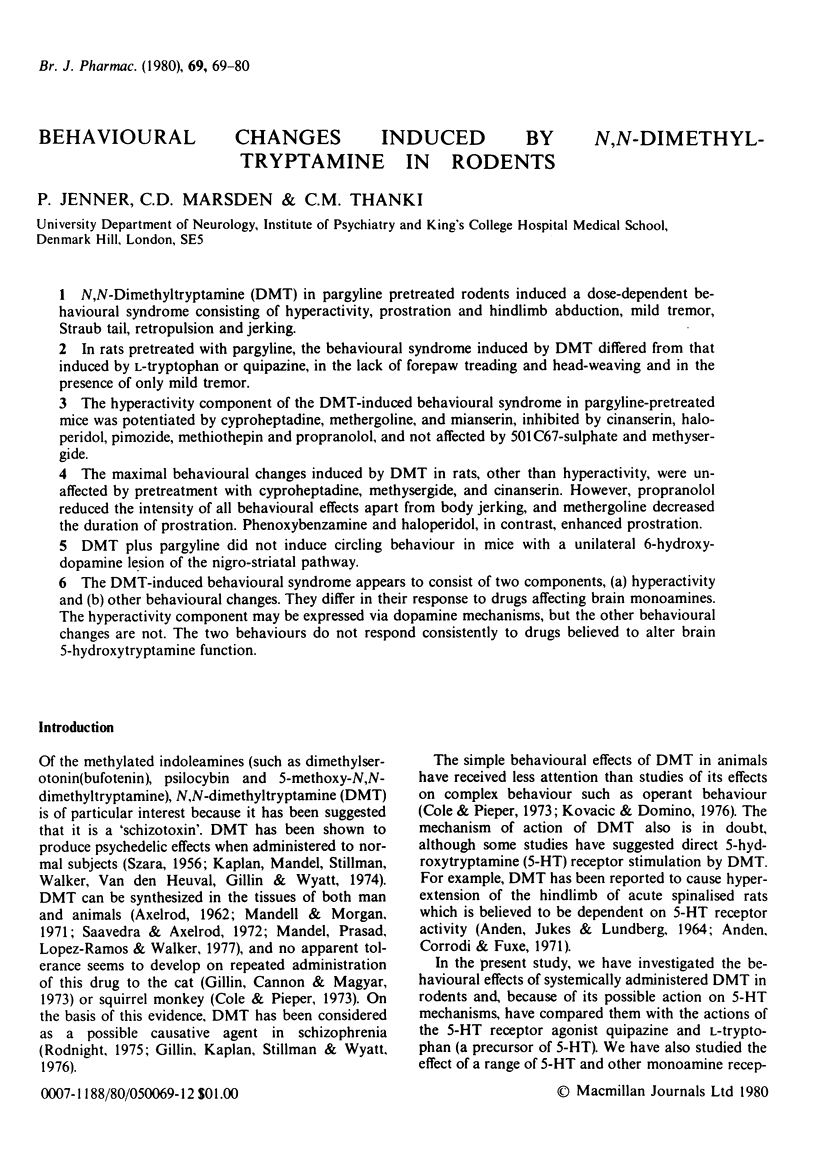
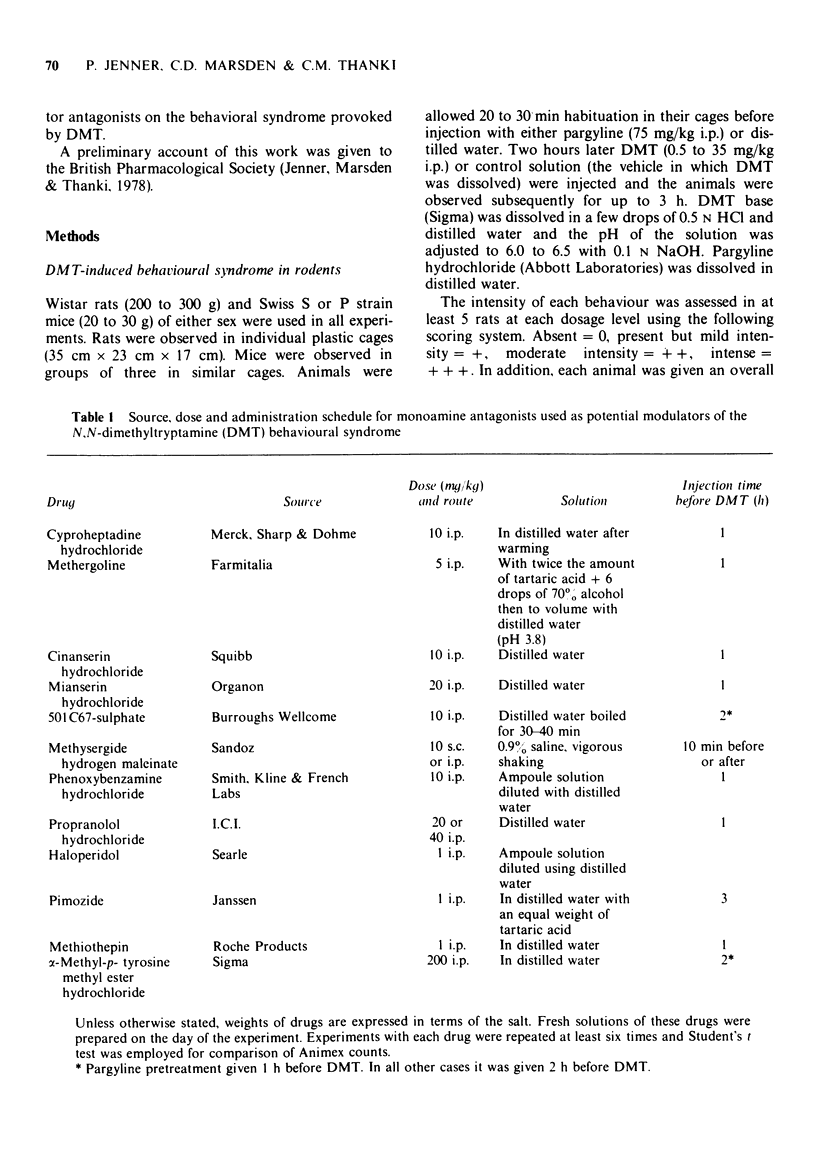
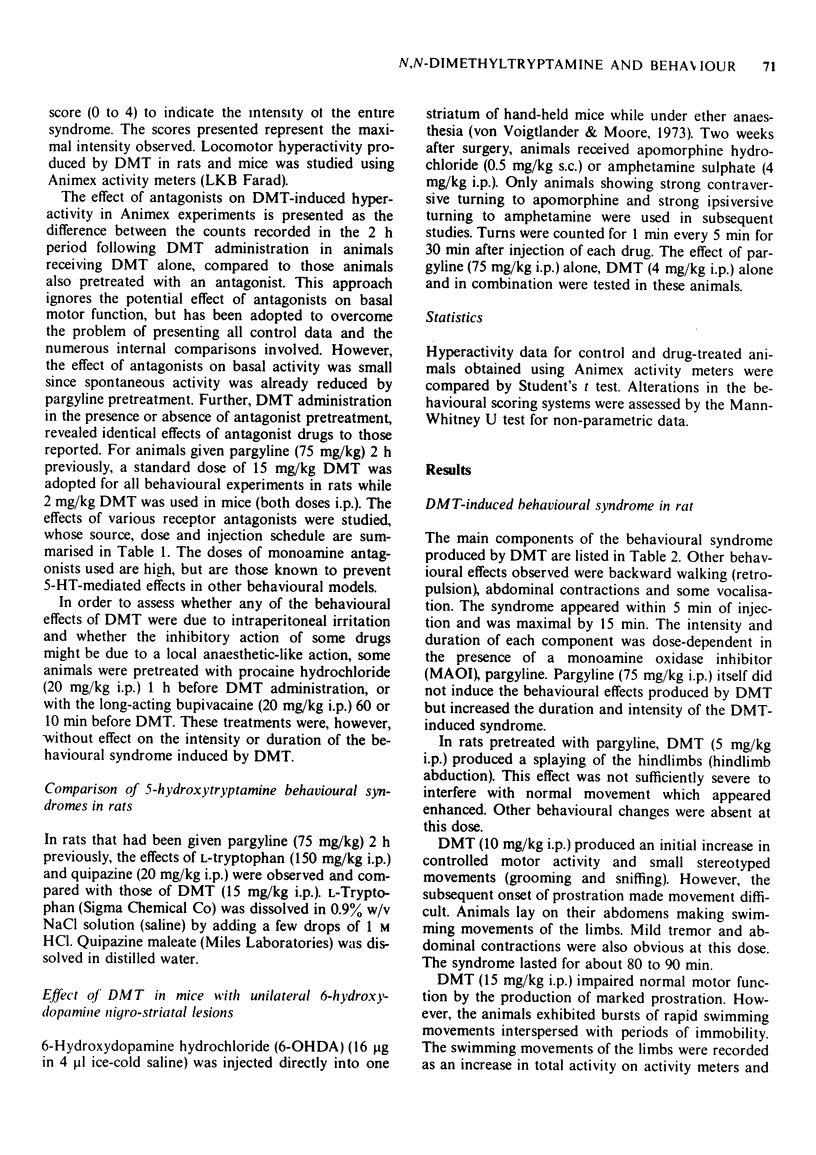
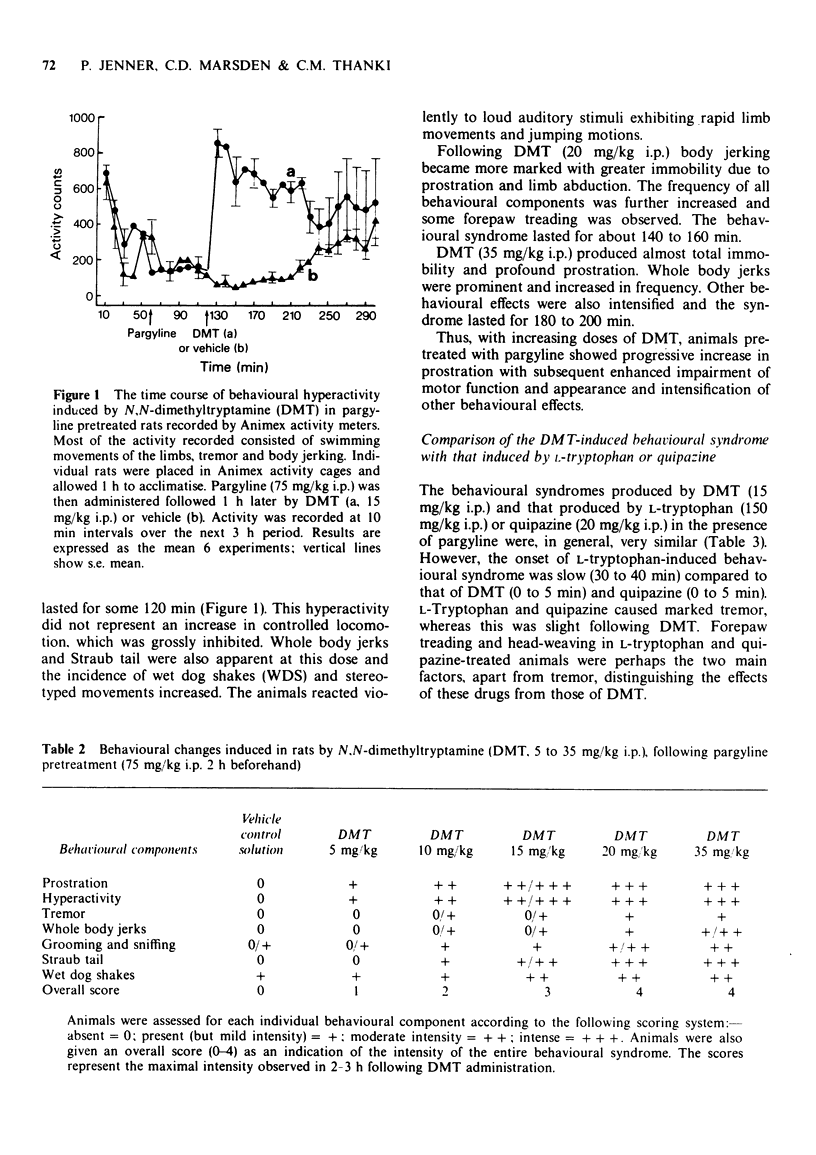
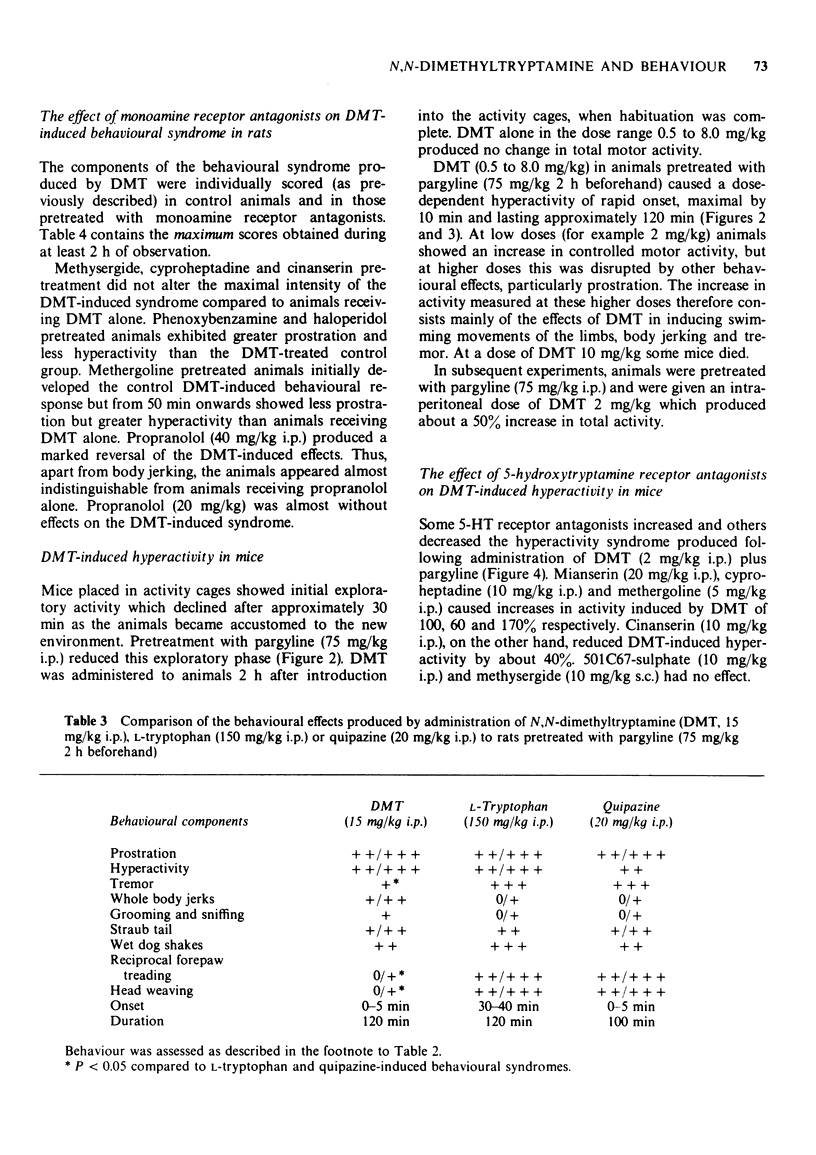
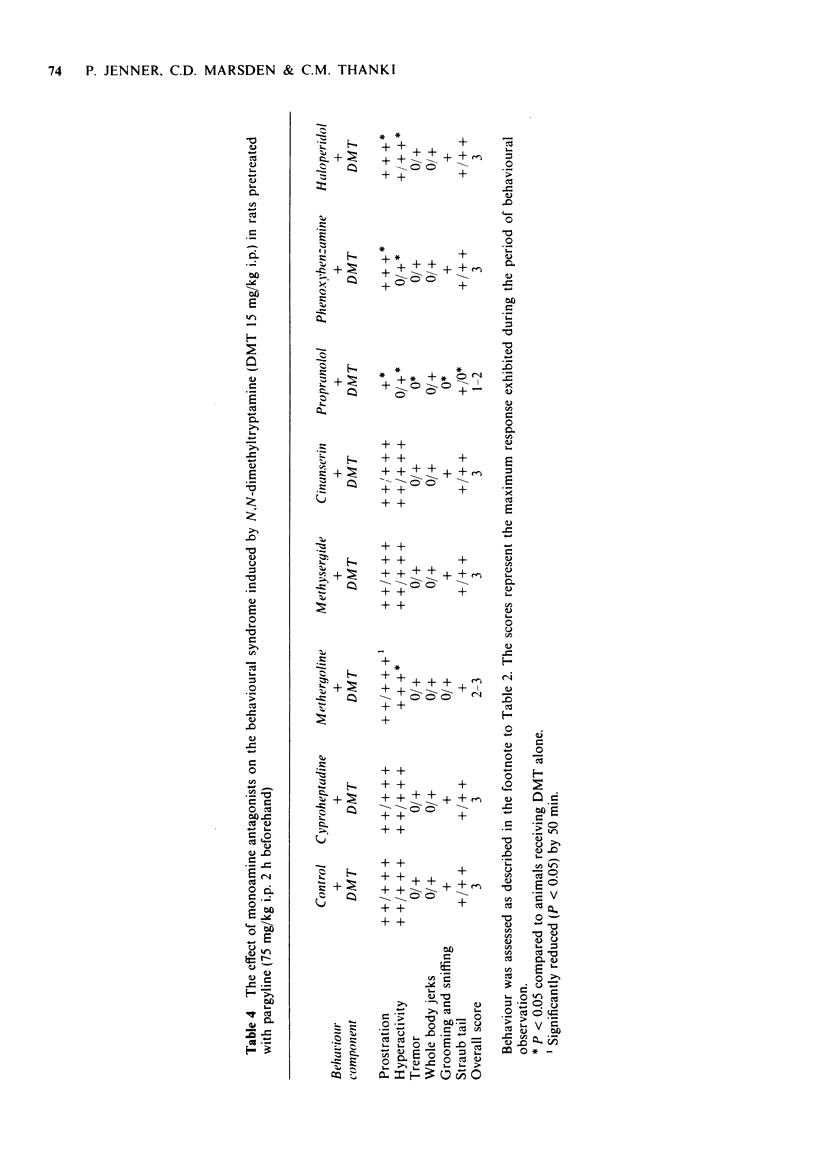
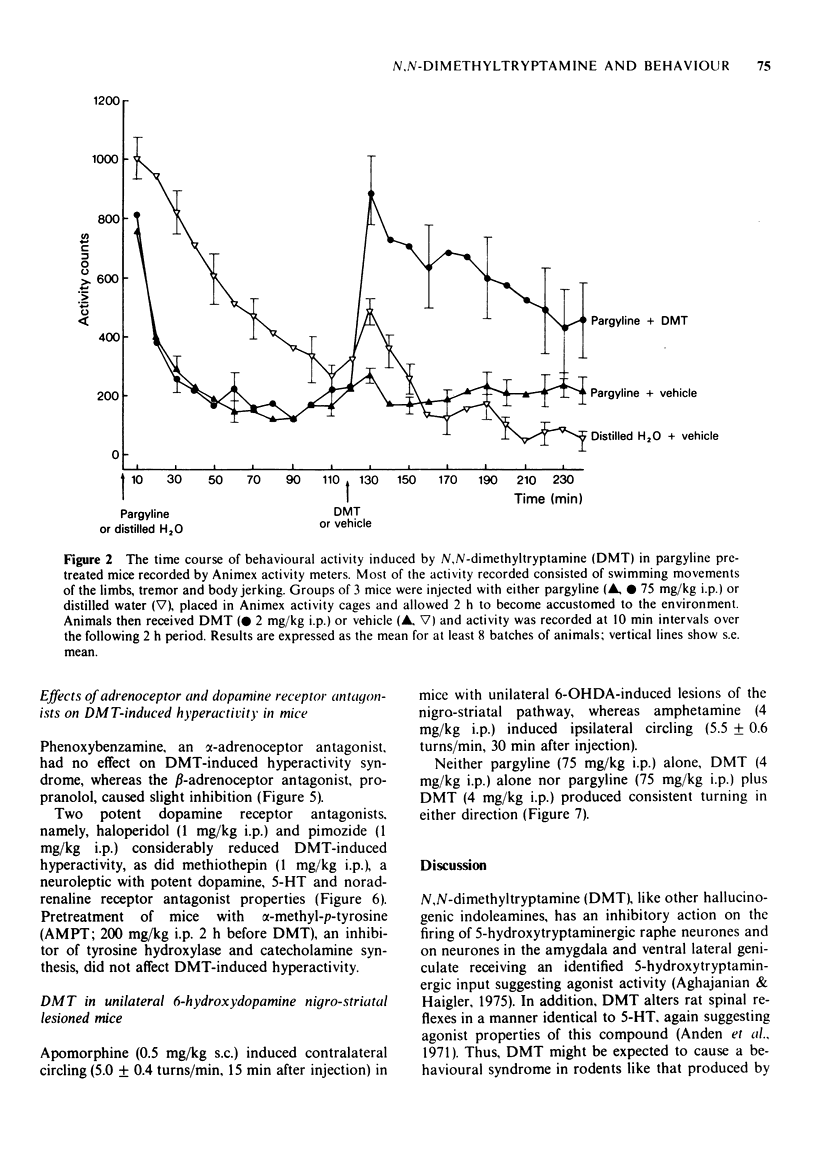
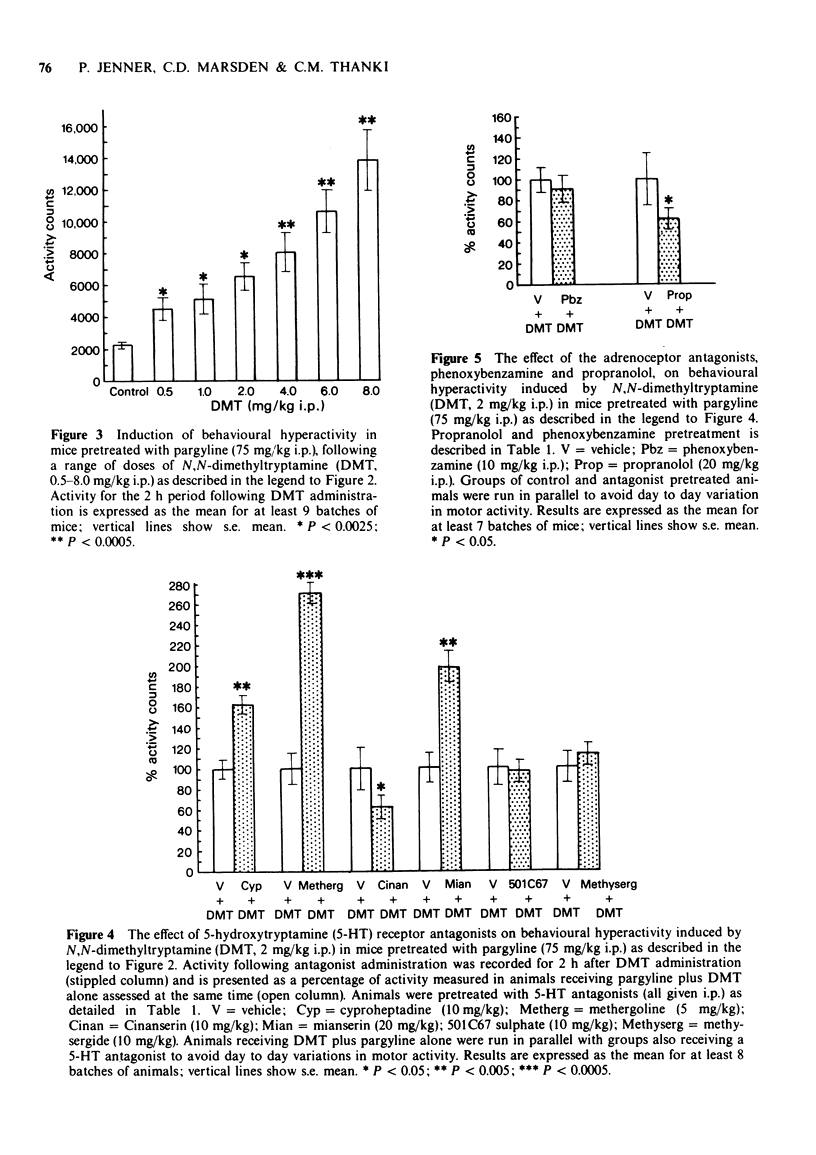
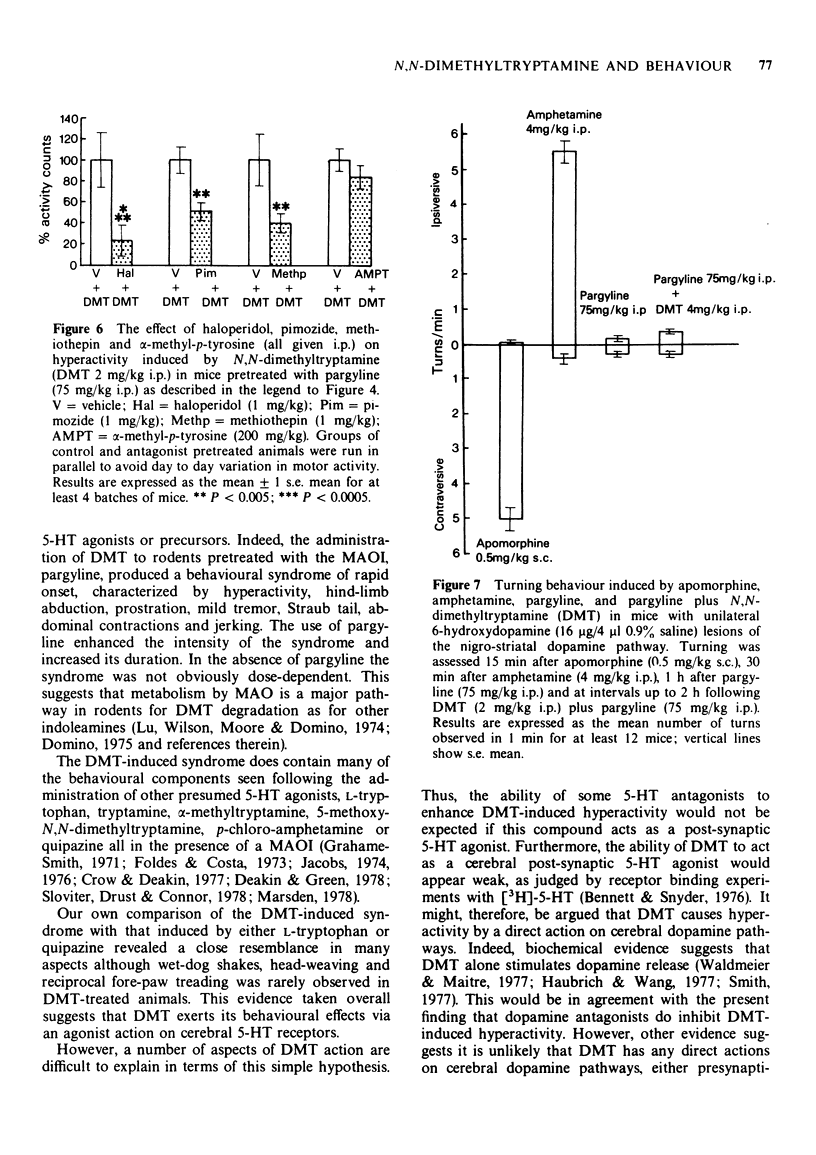
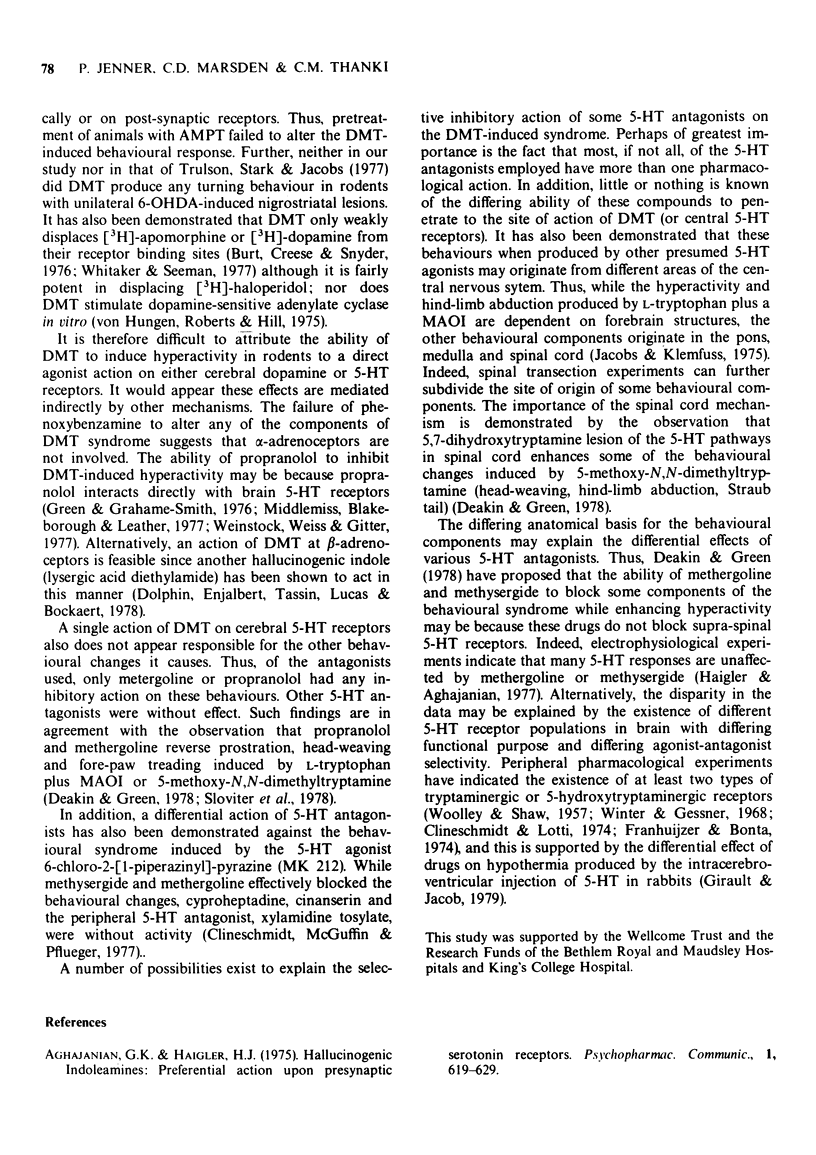
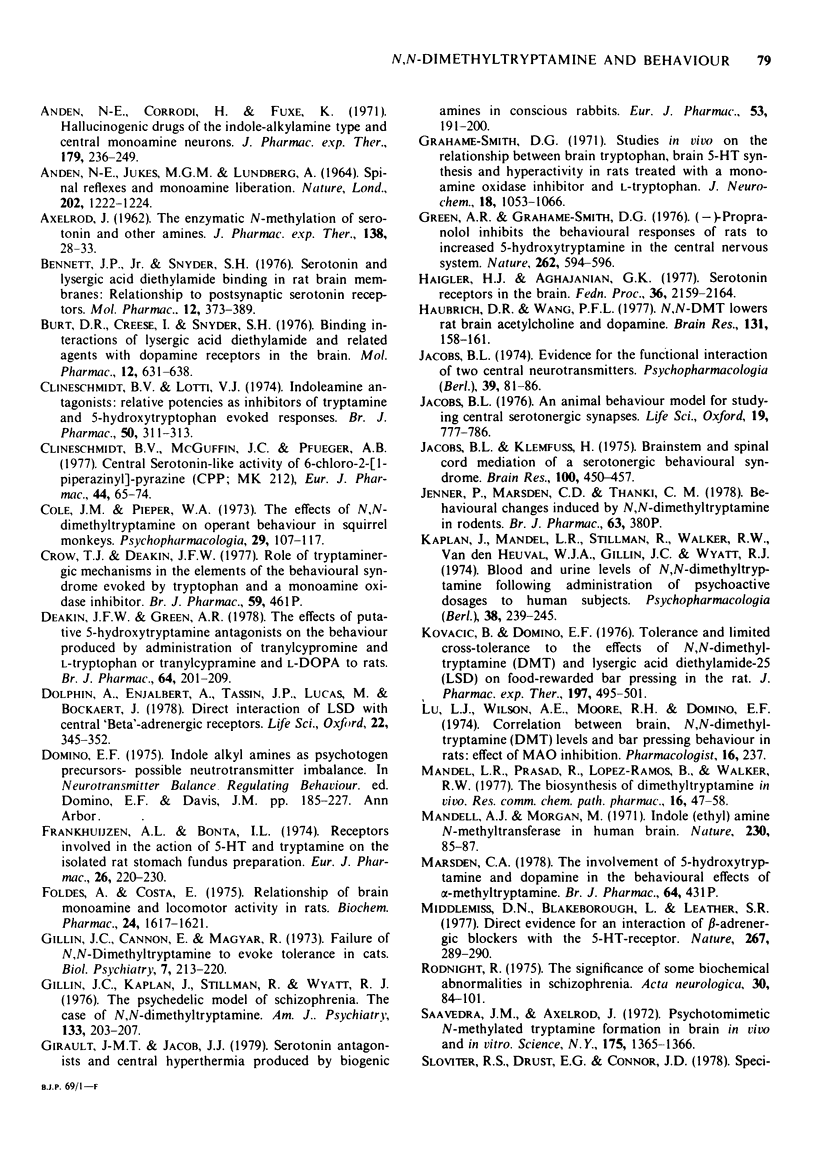
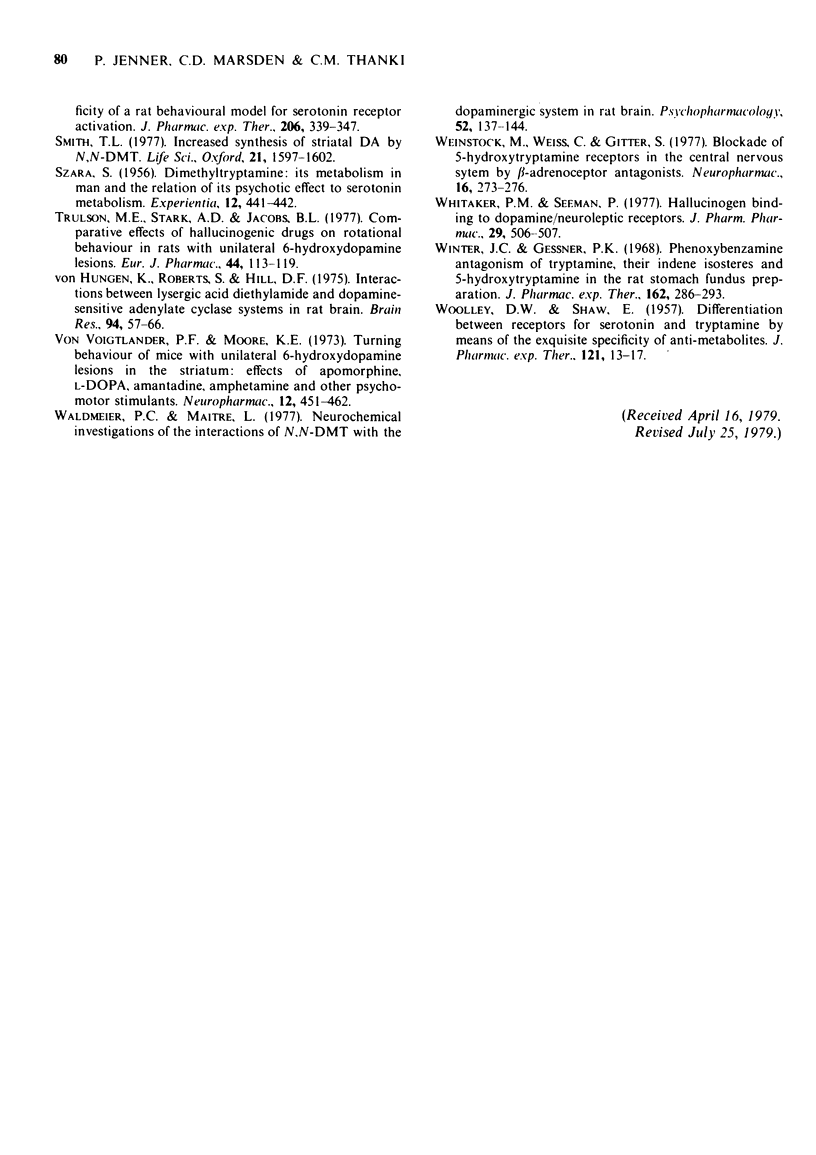
Selected References
These references are in PubMed. This may not be the complete list of references from this article.
- ANDEN N. E., JUKES M. G., LUNDBERG A. SPINAL REFLEXES AND MONOAMINE LIBERATION. Nature. 1964 Jun 20;202:1222–1223. doi: 10.1038/2021222a0. [DOI] [PubMed] [Google Scholar]
- AXELROD J. The enzymatic N-methylation of serotonin and other amines. J Pharmacol Exp Ther. 1962 Oct;138:28–33. [PubMed] [Google Scholar]
- Aghajanian G. K., Hailgler H. J. Hallucinogenic indoleamines: Preferential action upon presynaptic serotonin receptors. Psychopharmacol Commun. 1975;1(6):619–629. [PubMed] [Google Scholar]
- Andén N. E., Corrodi H., Fuxe K. Hallucinogenic drugs of the indolealkylamine type and central monoamine neurons. J Pharmacol Exp Ther. 1971 Nov;179(2):236–249. [PubMed] [Google Scholar]
- Bennett J. P., Jr, Snyder S. H. Serotonin and lysergic acid diethylamide binding in rat brain membranes: relationship to postsynaptic serotonin receptors. Mol Pharmacol. 1976 May;12(3):373–389. [PubMed] [Google Scholar]
- Burt D. R., Creese I., Snyder S. H. Binding interactions of lysergic acid diethylamide and related agents with dopamine receptors in the brain. Mol Pharmacol. 1976 Jul;12(4):631–638. [PubMed] [Google Scholar]
- Clineschmidt B. V., Lotti V. J. Indoleamine antagonists: relative potencies as inhibitors of tryptamine- and 5-hydroxytryptophan-evoked responses. Br J Pharmacol. 1974 Feb;50(2):311–313. doi: 10.1111/j.1476-5381.1974.tb08577.x. [DOI] [PMC free article] [PubMed] [Google Scholar]
- Clineschmidt B. V., Mcguffin J. C., Pflueger A. B. Central serotonin-like activity of 6-chloro-2-[1-piperazinyl]-pyrazine (CPP; MK-212). Eur J Pharmacol. 1977 Jul 1;44(1):65–74. doi: 10.1016/0014-2999(77)90117-0. [DOI] [PubMed] [Google Scholar]
- Cole J. M., Pieper W. A. The effects of N,N-dimethyltryptamine on operant behavior in squirrel monkeys. Psychopharmacologia. 1973 Mar 16;29(2):107–112. doi: 10.1007/BF00422642. [DOI] [PubMed] [Google Scholar]
- Deakin J. F., Green A. R. The effects of putative 5-hydroxytryptamine antagonists on the behaviour produced by administration of tranylcypromine and L-tryptophan or tranylcypromine and L-DOPA to rats. Br J Pharmacol. 1978 Oct;64(2):201–209. doi: 10.1111/j.1476-5381.1978.tb17290.x. [DOI] [PMC free article] [PubMed] [Google Scholar]
- Direct evidence for an interaction of beta-adrenergic blockers with the 5-HT receptor. Nature. 1977 May 19;267(5608):289–290. doi: 10.1038/267289a0. [DOI] [PubMed] [Google Scholar]
- Dolphin A., Enjalbert A., Tassin J. P., Lucas M., Bockaert J. Direct interaction of LSD with central "beta"-adrenergic receptors. Life Sci. 1978 Jan;22(4):345–352. doi: 10.1016/0024-3205(78)90142-x. [DOI] [PubMed] [Google Scholar]
- Foldes A., Costa E. Relationship of brain monoamine and locomotor activity in rats. Biochem Pharmacol. 1975 Sep 1;24(17):1617–1621. doi: 10.1016/0006-2952(75)90089-1. [DOI] [PubMed] [Google Scholar]
- Frankhuijzen A. L., Bonta I. L. Receptors involved in the action of 5-HT and tryptamine on the isolated rat stomach fundus preparation. Eur J Pharmacol. 1974 May;26(2):220–230. doi: 10.1016/0014-2999(74)90231-3. [DOI] [PubMed] [Google Scholar]
- Gillin J. C., Cannon E., Magyar R., Schwartz M., Wyatt R. J. Failure of N,N-dimethyltryptamine to evoke tolerance in cats. Biol Psychiatry. 1973 Dec;7(3):213–220. [PubMed] [Google Scholar]
- Gillin J. C., Kaplan J., Stillman R., Wyatt R. J. The psychedelic model of schizophrenia: the case of N,N-dimethyltryptamine. Am J Psychiatry. 1976 Feb;133(2):203–208. doi: 10.1176/ajp.133.2.203. [DOI] [PubMed] [Google Scholar]
- Girault J. M., Jacob J. J. Serotonin antagonists and central hyperthermia produced by biogenic amines in conscious rabbits. Eur J Pharmacol. 1979 Jan 1;53(2):191–200. doi: 10.1016/0014-2999(79)90165-1. [DOI] [PubMed] [Google Scholar]
- Grahame-Smith D. G. Studies in vivo on the relationship between brain tryptophan, brain 5-HT synthesis and hyperactivity in rats treated with a monoamine oxidase inhibitor and L-tryptophan. J Neurochem. 1971 Jun;18(6):1053–1066. doi: 10.1111/j.1471-4159.1971.tb12034.x. [DOI] [PubMed] [Google Scholar]
- Green A. R., Grahame-Smith D. G. (-)-Propranolol inhibits the behavioural responses of rats to increased 5-hydroxytryptamine in the central nervous system. Nature. 1976 Aug 12;262(5569):594–596. doi: 10.1038/262594a0. [DOI] [PubMed] [Google Scholar]
- Haigler H. J., Aghajanian G. K. Serotonin receptors in the brain. Fed Proc. 1977 Jul;36(8):2159–2164. [PubMed] [Google Scholar]
- Haubrich D. R., Wang P. F. N'N-dimethyltryptamine lowers rat brain acetylcholine and dopamine. Brain Res. 1977 Aug 5;131(1):158–161. doi: 10.1016/0006-8993(77)90036-1. [DOI] [PubMed] [Google Scholar]
- Hungen K. V., Roberts S., Hill D. F. Interactions between lysergic acid diethylamide and dopamine-sensitive adenylate cyclase systems in rat brain. Brain Res. 1975 Aug 22;94(1):57–66. doi: 10.1016/0006-8993(75)90876-8. [DOI] [PubMed] [Google Scholar]
- Jacobs B. L. An animal behavior model for studying central serotonergic synapses. Life Sci. 1976 Sep 15;19(6):777–785. doi: 10.1016/0024-3205(76)90303-9. [DOI] [PubMed] [Google Scholar]
- Jacobs B. L. Evidence for the functional interaction of two central neurotransmitters. Psychopharmacologia. 1974;39(1):81–86. doi: 10.1007/BF00421461. [DOI] [PubMed] [Google Scholar]
- Jacobs B. L., Klemfuss H. Brain stem and spinal cord mediation of a serotonergic behavioral syndrome. Brain Res. 1975 Dec 19;100(2):450–457. doi: 10.1016/0006-8993(75)90500-4. [DOI] [PubMed] [Google Scholar]
- Jenner P., Marsden C. D., Thanki C. M. Behavioural changes induced by N,N-dimethyltryptamine in rodents [proceedings]. Br J Pharmacol. 1978 Jun;63(2):380P–380P. [PMC free article] [PubMed] [Google Scholar]
- Kaplan J., Mandel L. R., Stillman R., Walker R. W., VandenHeuvel W. J., Gillin J. C., Wyatt R. J. Blood and urine levels of N,N-dimethyltryptamine following administration of psychoactive dosages to human subjects. Psychopharmacologia. 1974;38(3):239–245. doi: 10.1007/BF00421376. [DOI] [PubMed] [Google Scholar]
- Kovacic B., Domino E. F. Tolerance and limited cross-tolerance to the effects of N, N-dimethyltryptamine (DMT) and lysergic acid diethylamide-25 (LSD) on food-rewarded bar pressing in the rat. J Pharmacol Exp Ther. 1976 Jun;197(3):495–502. [PubMed] [Google Scholar]
- Mandel L. R., Prasad R., Lopez-Ramos B., Walker R. W. The biosynthesis of dimethyltryptamine in vivo. Res Commun Chem Pathol Pharmacol. 1977 Jan;16(1):47–58. [PubMed] [Google Scholar]
- Mandell A. J., Morgan M. Indole(ethyl)amine N-methyltransferase in human brain. Nat New Biol. 1971 Mar 17;230(11):85–87. doi: 10.1038/newbio230085a0. [DOI] [PubMed] [Google Scholar]
- Rodnight R. The significance of some biochemical abnormalities in schizophrenia. Acta Neurol (Napoli) 1975 Jan-Feb;30(1):85–101. [PubMed] [Google Scholar]
- SZARA S. Dimethyltryptamin: its metabolism in man; the relation to its psychotic effect to the serotonin metabolism. Experientia. 1956 Nov 15;12(11):441–442. doi: 10.1007/BF02157378. [DOI] [PubMed] [Google Scholar]
- Saavedra J. M., Axelrod J. Psychotomimetic N-methylated tryptamines: formation in brain in vivo and in vitro. Science. 1972 Mar 24;175(4028):1365–1366. doi: 10.1126/science.175.4028.1365. [DOI] [PubMed] [Google Scholar]
- Sloviter R. S., Drust E. G., Connor J. D. Specificity of a rat behavioral model for serotonin receptor activation. J Pharmacol Exp Ther. 1978 Aug;206(2):339–347. [PubMed] [Google Scholar]
- Trulson M. E., Stark A. D., Jacobs B. L. Comparative effects of hallucinogenic drugs on rotational behavior in rats with unilateral 6-hydroxydopamine lesions. Eur J Pharmacol. 1977 Jul 15;44(2):113–119. doi: 10.1016/0014-2999(77)90097-8. [DOI] [PubMed] [Google Scholar]
- Von Voigtlander P. F., Moore K. E. Turning behavior of mice with unilateral 6-hydroxydopamine lesions in the striatum: effects of apomorphine, L-DOPA, amanthadine, amphetamine and other psychomotor stimulants. Neuropharmacology. 1973 May;12(5):451–462. doi: 10.1016/0028-3908(73)90061-0. [DOI] [PubMed] [Google Scholar]
- WOOLLEY D. W., SHAW E. Differentiation between receptors for serotonin and tryptamine by means of the exquisite specificity of antimetabolites. J Pharmacol Exp Ther. 1957 Sep;121(1):13–17. [PubMed] [Google Scholar]
- Weinstock M., Weiss C., Gitter S. Blockade of 5-hydroxytryptamine receptors in the central nervous system by beta-adrenoceptor antagonists. Neuropharmacology. 1977 Apr;16(4):273–276. doi: 10.1016/0028-3908(77)90106-x. [DOI] [PubMed] [Google Scholar]
- Whitaker P. M., Seeman P. Hallucinogen binding to dopamine/neuroleptic receptors. J Pharm Pharmacol. 1977 Aug;29(8):506–507. doi: 10.1111/j.2042-7158.1977.tb11381.x. [DOI] [PubMed] [Google Scholar]
- Winter J. C., Gessner P. K. Phenoxybenzamine antagonism of tryptamines, their indene isosteres and 5-hydroxytryptamine in the rat stomach fundus preparation. J Pharmacol Exp Ther. 1968 Aug;162(2):286–293. [PubMed] [Google Scholar]


